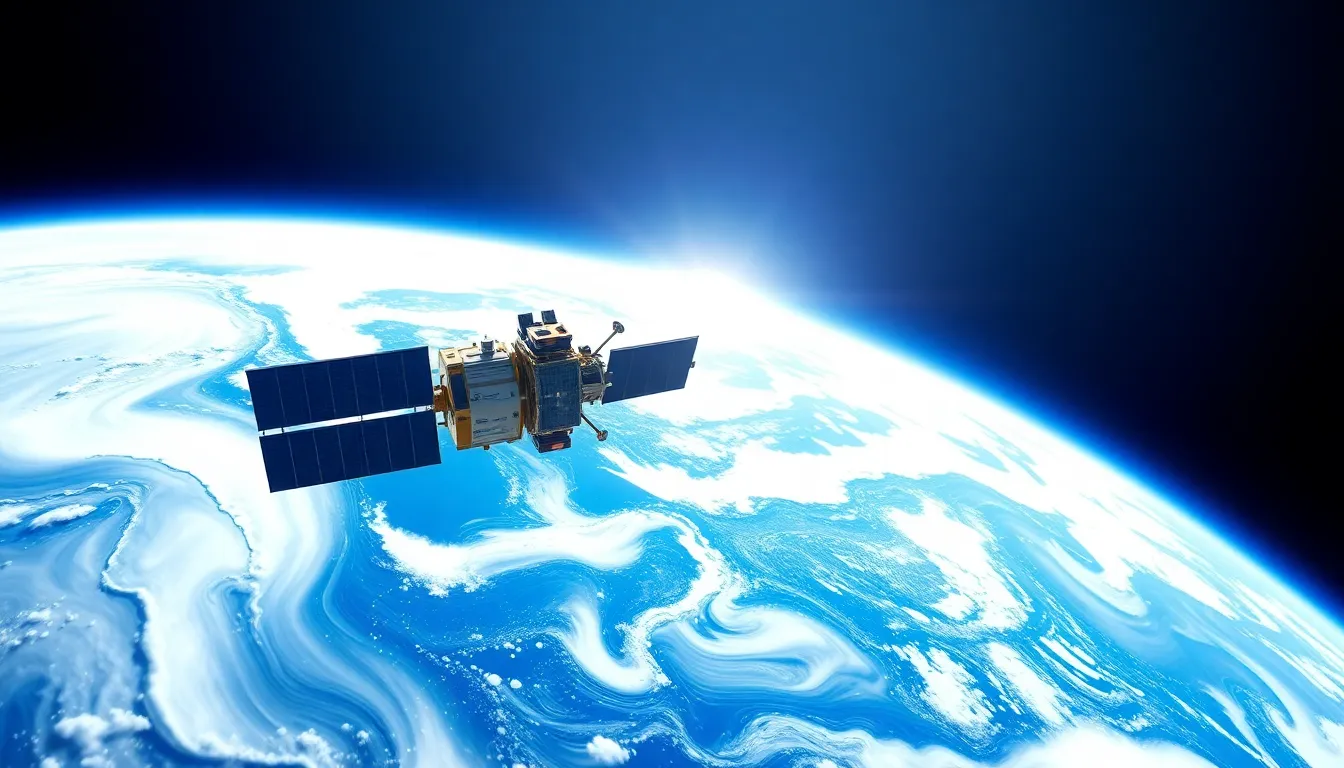Table of Contents
ToggleLow Earth Orbit, or LEO as the cool kids call it, is the sweet spot for satellites and space enthusiasts alike. Nestled between 100 and 1,200 miles above Earth, this region is where the magic happens—think faster communication, stunning imagery, and a front-row seat to the cosmos. It’s like the VIP lounge of space, where everything from weather satellites to the latest in space tourism is taking place.
Overview of Low Earth Orbit
Low Earth Orbit (LEO) serves as a crucial zone for many satellites, positioned between 100 and 1,200 miles above the Earth’s surface. This region allows satellites to maintain a closer proximity to the planet, enhancing communication speeds and reducing latency. Communication satellites, for instance, benefit significantly from LEO, enabling faster data transmission compared to those in higher orbits.
Impressive imagery quality is another advantage associated with LEO satellites. Earth observation satellites in this orbit capture high-resolution images, which are vital for environmental monitoring, urban planning, and disaster response. These capabilities have made LEO a preferred choice for both governmental and commercial entities.
Applications extend beyond communication and imaging. LEO supports various functions, including weather monitoring, international research collaborations, and even space tourism ventures. As space accessibility increases, more companies explore opportunities to utilize LEO for tourism experiences, making space travel more attainable.
Regulatory frameworks also play a role in LEO operations. National and international guidelines help manage space traffic, ensuring the safety of satellites and crews involved in missions. Collaborative efforts promote the sustainable use of this orbital area, addressing issues like space debris and spectrum management.
Elevated interest in LEO has sparked numerous developments in technology and infrastructure. Emerging launch systems and advanced satellite designs drive innovation within the industry. With the focus on LEO poised to grow, numerous advancements will likely redefine space exploration and satellite deployment strategies.
Characteristics of Low Earth Orbit

Low Earth Orbit (LEO) possesses unique features that make it advantageous for various satellite applications. Understanding its characteristics helps in effective satellite design and deployment.
Altitude Range
LEO generally spans altitudes from 100 miles to 1,200 miles above Earth’s surface. Satellites within this range maintain closer proximity to Earth, allowing them to provide real-time data and reduce signal latency. For instance, communication satellites benefit from this reduced distance, facilitating immediate contact. Earth observation satellites also thrive in this orbit, capturing high-resolution images critical for monitoring environmental changes. Regulatory bodies often emphasize the significance of this altitude range, guiding satellite operators for optimal performance and safety.
Orbital Period
The orbital period for satellites in LEO typically lasts between 90 and 120 minutes. Shorter periods enable satellites to complete multiple orbits in a single day, enhancing their ability to gather data frequently. Many Earth observation satellites, for example, can map extensive areas within hours. Quick revisiting times improve response capabilities for disaster management and agricultural monitoring. In addition, this rapid orbital cycle supports the deployment of megaconstellations, enabling extensive coverage and global connectivity.
Applications of Low Earth Orbit
Low Earth Orbit (LEO) supports a range of vital applications, making it essential for modern technology and exploration.
Satellite Deployment
Satellites launched into LEO enable efficient deployment strategies across various sectors. Communication satellites benefit from this orbit, delivering high-speed internet and voice services globally. Earth observation satellites capture images used for monitoring climate change, agriculture, and urban development. Navigation satellites enhance precision in location services and navigation systems. These deployments provide numerous advantages, such as reduced latency and improved data transmission rates.
Space Missions
Space missions in LEO focus on scientific research and technology demonstration. Scientists use LEO for experiments that require microgravity, advancing knowledge in fields like biology and materials science. Crew missions to the International Space Station facilitate international collaboration and research in space. Additionally, growing interest in space tourism sees companies planning commercial flights to LEO. Each mission contributes significantly to understanding human adaptability in space and the development of future exploration technologies.
Challenges in Low Earth Orbit
Low Earth Orbit presents several challenges that impact satellite operation and space missions. These challenges include managing space debris and addressing radiation exposure.
Space Debris
Space debris poses a significant risk to satellites operating in Low Earth Orbit. Debris includes defunct satellites, spent rocket stages, and fragments from collisions. Estimates reveal over 34,000 pieces of debris larger than 10 centimeters in orbit. This debris can jeopardize functioning satellites, potentially leading to costly damages or mission failures. Effective tracking and collision avoidance tactics are essential for ensuring satellite safety. In response to increasing debris, international regulations promote sustainable practices for satellite design and end-of-life strategies.
Radiation Exposure
Radiation exposure constitutes another challenge for satellites in Low Earth Orbit. Located closer to Earth, satellites encounter heightened levels of radiation from cosmic rays and solar particles. Prolonged exposure can lead to malfunctions in electronic components and degrade materials used in satellite construction. Shielding strategies become vital for minimizing radiation’s effects. Engineers focus on developing robust systems to withstand these conditions while maintaining satellite functionality. Studies highlight the importance of understanding radiation impacts for future LEO missions, including crewed activities and long-term satellite deployments.
Future of Low Earth Orbit
Technological advancements promise to expand the capabilities of Low Earth Orbit (LEO). New launch systems are emerging, allowing for more cost-effective satellite deployments. Satellite designs are evolving to address the challenges of space debris and radiation exposure effectively.
Increased demand for satellite services fuels this growth. Commercial applications now include high-speed internet, Earth observation, and navigation services. Companies are investing heavily in LEO infrastructure to support these services, positioning LEO as a key player in global communications.
Space tourism is gaining traction as well. Several companies are developing spacecraft aimed at transporting tourists to LEO. This burgeoning industry will likely increase public interest in space and inspire future generations of scientists and engineers.
International collaboration plays a crucial role in shaping the future of LEO. Organizations are working together to establish regulatory frameworks, addressing the growing concern of space debris. Implementing sustainable practices ensures responsible development of satellite programs while maintaining orbital safety.
Mathematics of satellite operations continues to improve, enhancing data collection and analysis capabilities. The frequent orbits of LEO satellites allow for timely information, which is invaluable during natural disasters or environmental monitoring events. As understanding of LEO dynamics increases, so too does the potential for innovative applications.
Safety measures against radiation exposure are evolving. Engineers develop advanced shielding technologies to protect satellites and crew members during missions. Learning from past missions informs these advancements, promoting safe human activities and satellite longevity.
Continued investment in research and development will drive future LEO initiatives. The focus on sustainability, safety, and efficient operations positions LEO as an essential element of contemporary and future space exploration.
Low Earth Orbit stands at the forefront of modern space exploration and satellite technology. Its unique advantages in communication speed and data collection make it indispensable for various sectors. As advancements continue to evolve in satellite design and launch systems, LEO’s potential will only grow.
The challenges of space debris and radiation exposure underscore the need for sustainable practices and innovative engineering solutions. International collaboration will play a vital role in shaping the future landscape of LEO, ensuring that it remains a safe and productive environment for both current and future missions.
With increasing investments and interest in space tourism and satellite services, LEO is poised to become a cornerstone of global communications and exploration efforts. The future of Low Earth Orbit promises exciting developments that will enhance our understanding of space and improve life on Earth.





